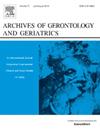Association of neighborhood physical environment with falls and fear of falling in older adults: A prospective cohort study
IF 3.8
3区 医学
Q2 GERIATRICS & GERONTOLOGY
引用次数: 0
Abstract
Objectives
To explore the prospective association between physical environment characteristics of the neighborhood and risk of falls/fear of falling among community-dwelling older adults.
Study Design
Prospective cohort analysis using data from the Seniors-ENRICA-2 cohort (metropolitan Madrid, Spain).
Methods
At baseline (2015–17), a neighborhood physical characteristics score was developed using the Physical Activity Neighborhood Environment Scale and an additional indicator of distance to green areas. In the second wave of follow-up (2019–20) we collected self-reported incident falls and fear of falling, assessed with the Short Falls Efficacy Scale International. Adjusted odds ratios (OR) and 95 % confidence intervals (CI) for the association between neighborhood environment perception and incidence of falls/fear of falling were calculated using logistic regression.
Results
Among 1823 participants, 27.7 % reported a fall during the previous year and 32.1 % were concerned about having a fall. Better neighborhood environment was associated with lower risk of falls (OR: 0.75; 95 %CI: 0.57–0.99) and fear of falling (0.73; 0.55–0.96). Specifically, low traffic intensity (0.68; 0.52–0.90) and sidewalks in good condition (0.75; 0.59–0.95) were associated with lower risk of falling. Moreover, available facilities for biking (0.77; 0.61–0.96), sidewalks in good condition (0.67; 0.52–0.86), night security (0.80; 0.60–0.99) and day security (0.62; 0.44–0.98) were independently associated with lower fear of falling.
Conclusions
Better neighborhood physical environments could play a key role in the prevention of falls and fear of falling among older adults. Policies aiming to improve residential environments can have broad implications for achieving healthy aging.
社区物理环境与老年人跌倒和害怕跌倒的关系:一项前瞻性队列研究
目的探讨社区居住老年人社区物理环境特征与跌倒风险/跌倒恐惧之间的潜在关联。前瞻性队列分析使用的数据来自senior - enrica -2队列(西班牙马德里大都会)。方法在基线(2015-17)阶段,采用体育活动邻里环境量表和到绿地距离的附加指标编制邻里体质特征评分。在第二波随访(2019 - 2020年)中,我们收集了自我报告的跌倒事件和害怕跌倒的情况,并使用国际短跌倒疗效量表进行评估。使用逻辑回归计算邻里环境感知与跌倒/害怕跌倒发生率之间的校正比值比(OR)和95%置信区间(CI)。结果在1823名参与者中,27.7%的人报告在过去一年中跌倒,32.1%的人担心跌倒。良好的社区环境与较低的跌倒风险相关(OR: 0.75;95% CI: 0.57-0.99)和对跌倒的恐惧(0.73;0.55 - -0.96)。具体而言,低交通强度(0.68;0.52-0.90)及人行道状况良好(0.75;0.59-0.95)与较低的跌倒风险相关。此外,可用的自行车设施(0.77;人行道状况良好(0.67;0.52-0.86),夜间安全性(0.80;0.60-0.99)和日安全性(0.62;0.44-0.98)与较低的跌倒恐惧独立相关。结论良好的社区物理环境可能在预防老年人跌倒和害怕跌倒方面发挥关键作用。旨在改善居住环境的政策可以对实现健康老龄化产生广泛影响。
本文章由计算机程序翻译,如有差异,请以英文原文为准。
求助全文
约1分钟内获得全文
求助全文
来源期刊
CiteScore
7.30
自引率
5.00%
发文量
198
审稿时长
16 days
期刊介绍:
Archives of Gerontology and Geriatrics provides a medium for the publication of papers from the fields of experimental gerontology and clinical and social geriatrics. The principal aim of the journal is to facilitate the exchange of information between specialists in these three fields of gerontological research. Experimental papers dealing with the basic mechanisms of aging at molecular, cellular, tissue or organ levels will be published.
Clinical papers will be accepted if they provide sufficiently new information or are of fundamental importance for the knowledge of human aging. Purely descriptive clinical papers will be accepted only if the results permit further interpretation. Papers dealing with anti-aging pharmacological preparations in humans are welcome. Papers on the social aspects of geriatrics will be accepted if they are of general interest regarding the epidemiology of aging and the efficiency and working methods of the social organizations for the health care of the elderly.

 求助内容:
求助内容: 应助结果提醒方式:
应助结果提醒方式:


